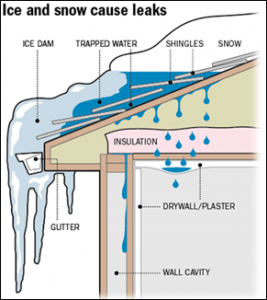What are Ice Dams? Can They Be Avoided?
Posted on Sunday, March 14th, 2021 | 2,941 views
Ice dams are formed by continual thawing and refreezing of melting snow. Large masses of ice develop as snow on the upper part of the roof melts. The water runs under the snow and refreezes at the edge of the roof.
 Additional snow melts and forms pools against the dam, gradually causing water to back up on the roof where it often gets under the shingles and eventually into the house. Causes other than heat escaping from the home include:
Additional snow melts and forms pools against the dam, gradually causing water to back up on the roof where it often gets under the shingles and eventually into the house. Causes other than heat escaping from the home include:
- Bright sunshine melting the snow;
- Insufficient attic insulation allowing the heated air of the attic to reach the roof deck and melt the snow, which could happen anywhere on the roof surface;
- Naturally occurring ice accumulation due to various weather conditions;
- Poorly placed gutters preventing snow and ice from sliding off the roof;
- Inadequate attic ventilation.
The latent damage from ice dams may not be immediately evident. For example, insulation could be getting wet and over time will lose its ability to perform properly. In addition, mold may begin to grow in the moist attic environment. Although ice dams are more prevalent at the eaves, they can (and do) occur anywhere on the roof, especially where there is a change in roof surface temperatures.
Can This Be Avoided?
Canadian weather is challenging to say the least and, as we all know, there is only so much you can do to avoid its impact. But, having said that, there are some things you can do to minimize the risks of developing ice dams on your roof.
- If you have a large deposit of snow, particularly in bad areas like a valley running into a wall or a saddle area, removing the snow is your best option. Any large deposits at the eaves, especially on the north side, should be removed as well.
- Install a leak barrier such as StormGuard® or WeatherWatch® leak barriers. These impermeable membranes prevent water from entering through the roof deck.
- Improve attic insulation in order to keep the attic space cool, thereby reducing the amount of melting snow.
- Improve attic ventilation to ensure that the attic remains cool.
- Make sure that your gutters or eavestroughs are lower than the slope of the roof, allowing snow and ice to glide off.
And remember … the expert staff at Desi’s Roofing are here to assist you with this, or with any other questions you may have. Simply visit our roofing estimate page to schedule an appointment.
Read More...
 Desi's Roofing has been providing high quality roofing services in Burlington since 1959 on a foundation of quality work and customer service. We publish these articles in order to help our customers and casual readers to get the most out of their roof and learn to manage and maintain it over the years.
Desi's Roofing has been providing high quality roofing services in Burlington since 1959 on a foundation of quality work and customer service. We publish these articles in order to help our customers and casual readers to get the most out of their roof and learn to manage and maintain it over the years.
If there is a particular subject you'd like us to write about feel free to contact us at 905-319-0880 anytime.
Leave a Reply